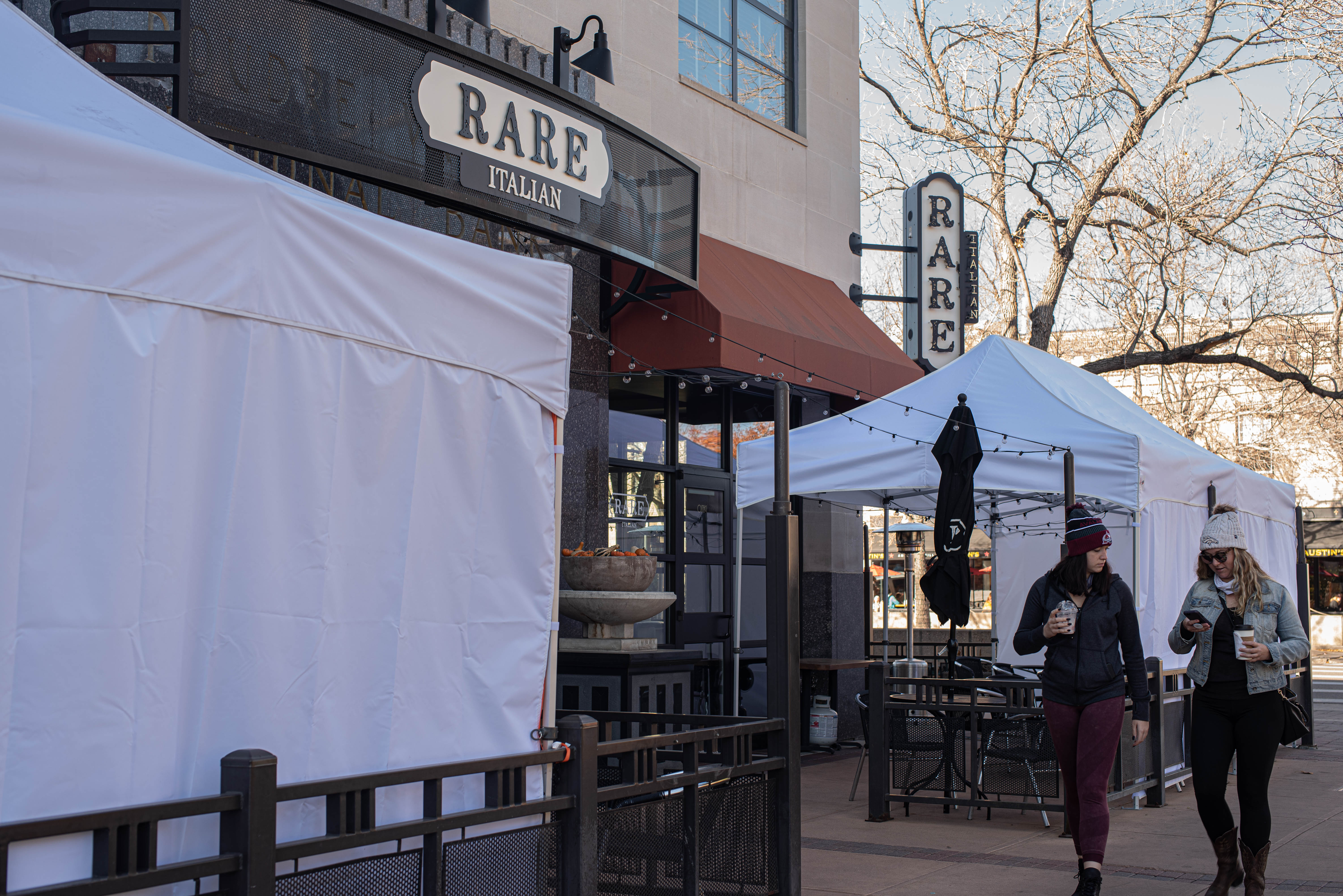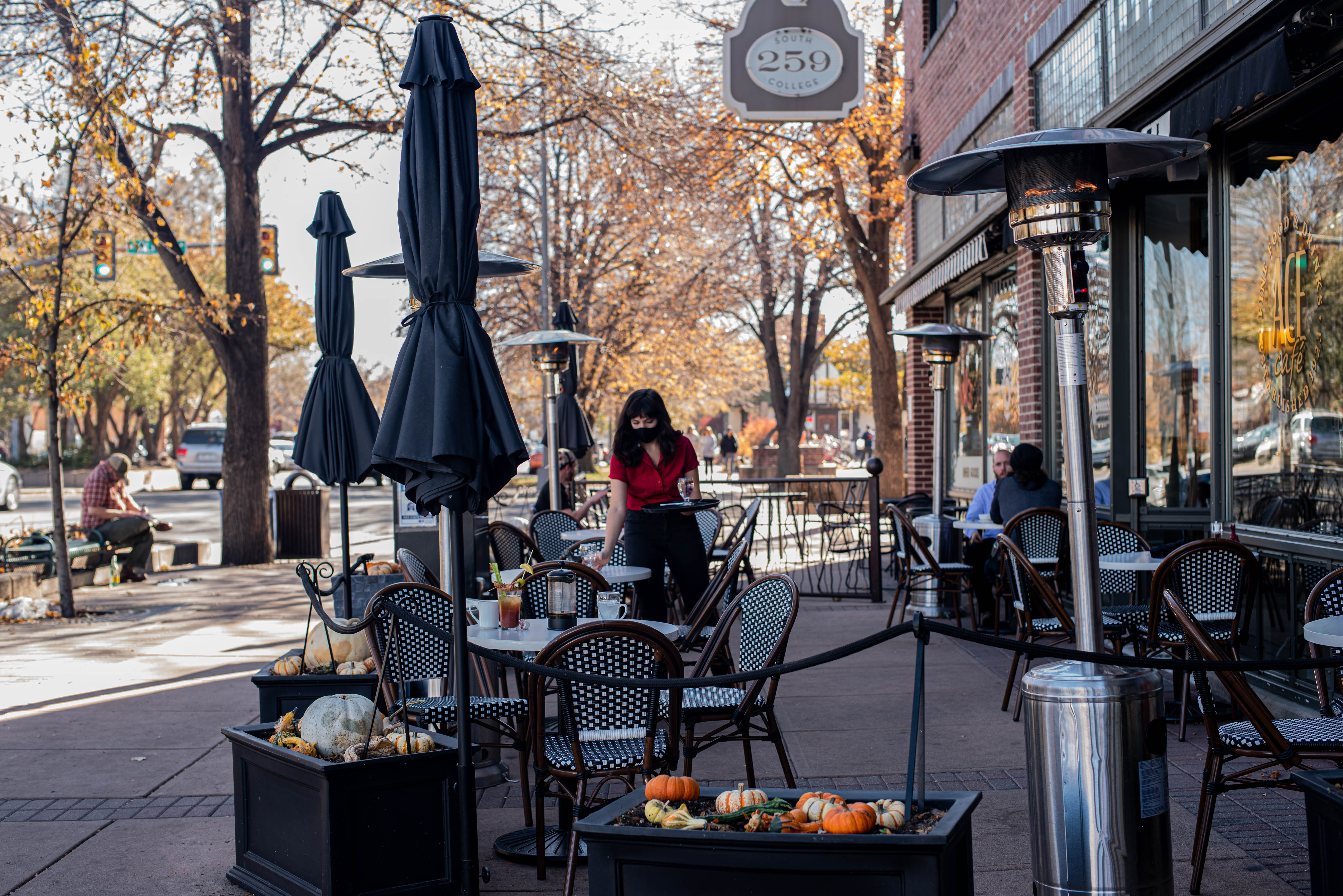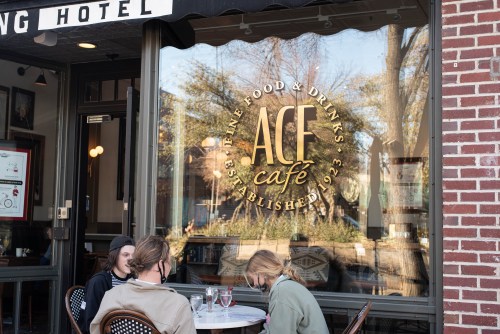By Emily Kemme
It’s been 243 days (and counting) since our family entered quasi-lockdown status. After official Stay-At-Home orders were loosened, our lifestyle hasn’t measurably altered from the lockdown days. The pandemic mindset is a numbing one. It boils down to calculations, tallying memories of when favorite activities were last experienced.
For example, I can’t recall when I last sat inside a dimly lit restaurant, caressing glowing flatware set on a white-clothed table while listening to the rhythmic tinkle of ice cubes being hurtled against the walls of a stainless steel martini shaker. Our waitress arrives, a cocktail glass skillfully balanced on a tray. Light beams from well-designed sconce placement lining the dining establishment’s walls. Their warmth is captured by the liquid, held for unmeasured seconds before the cocktail is savored alongside meaningful conversation.

(Photo: Emily Kemme)
Creating food and the spaces in which diners experience it is an art form. In that lies innovation, and for those who make it their profession to cook food for others, it is the chance to dream.
Innovation and open-mindedness continue to drive restaurants as closures loom
Gripped by a pandemic with no end in sight, among those hardest hit is the restaurant industry. In the Q&A below, Sonia Riggs, President and CEO of the Colorado Restaurant Association, sheds light on the state of Colorado’s restaurant industry, along with projections of what diners might see during the winter months.
EK: How many Colorado restaurants have closed, to date, or do you project will close that are a fallout of the coronavirus pandemic? Do you have a dollar amount of industry revenue losses?
SR: We know we’ve lost hundreds of restaurants across the state. More pressingly, [after the CRA’s October Restaurant Impact Survey] 50% are telling us they will consider closing permanently within 6 months, no doubt because they are worried about ongoing restrictions on capacity and because they have not seen a second round of significant cash relief at the federal level. The Colorado restaurant industry was a $14.5 billion industry in 2019, but it is down billions of dollars in 2020 — we estimate it lost nearly $1 billion in April alone.
EK: How many food service workers weren’t working during the pandemic lockdown stage and how many have since returned to work?
SR: During lockdown, we estimated about 70% — or 173,000 food and beverage hospitality workers — were furloughed or unemployed. Based on reporting staff levels, we estimate the industry has lost about one-third of its jobs — about 90,000 positions. It has become increasingly difficult for restaurateurs to hire back their full staff — with restaurateurs limited to 50% of their capacity, it is incredibly difficult to staff a full roster.
EK: What food service industry innovations have you observed as a result of the pandemic? Is the industry evolving and are positive, sustainable changes being made?
SR: This is an innovative industry, and we continue to hear stories about how restaurants are changing their operations to stay afloat: they’re adding new concepts out of existing kitchens (Bar Dough with Jabroni & Sons, Rioja with Flavor Dojo); growing and innovating within their takeout options (At Home With from Frasca, Peking duck feasts and batch cocktails from Ace Eat Serve, broth and gravy alongside chicken dinners from Chook Chicken), and preparing to winterize their patios so they can continue to serve outdoor diners throughout the cold months (yurts at Aurum in Breckenridge, greenhouses at Beast + Bottle).

EK: What advocacy work is the CRA engaged in to support innovations?
SR: CRA tries to clear regulatory roadblocks. . .. We successfully pushed for alcohol to-go and patio extension programs. We’re running an Outdoor Design Workshop with the State to conceptualize affordable, safe, and easy-to-implement winter outdoor dining solutions. We’ll follow that up with the [ Winter Outdoor Grant Program] to help restaurants pay for winterizing patios. We are closely monitoring the new public health orders and developments as we see counties move up and down the state dial and we work to get that information out to the industry quickly. We’re also running a virtual education series that aims to help Colorado restaurateurs find additional ways to tighten up their operations, including finding creative ways to keep cash on hand, and growing their takeout and delivery business.
Note: According to the October Restaurant Impact Survey, half of Colorado restaurants will take advantage of this program, recognizing they must spend $6,000 on average to make their patio usable during the winter.
EK: What are restaurants doing to stay connected to their patrons?
SR: During the shutdown, we saw a lot of online cooking and cocktail classes. Now, many — especially those that are more full-service — are being deliberate with their takeout experiences to connect with the guest. Sunday Vinyl sends orders home with a link to their Spotify playlist. Spuntino has done some really cool wine education alongside their weekly flights. And for dine-in, restaurants continue to go above and beyond safety procedures that were already in place to make guests feel safe and accommodated while they enjoy a meal.
EK: What is the future of the to-go concept? Has dining-at-home changed the face of the industry?
SR: To-go and delivery were growing pre-COVID-19, and the pandemic has accelerated the trend. We would expect to see some drop off, especially from full-service restaurants that haven’t traditionally offered takeout — we saw some of those operations pause in the summer when patios were full. This also speaks to the fact that there will continue to be a place for in-person dining — restaurants are critical parts of our community, and where we gather for a number of occasions.
Note: Restaurants indicated in the October Restaurant Impact Survey that 30% of revenue is derived from takeout, compared with 15% pre-pandemic. Three-quarters of restaurants plan to grow their takeout and delivery operations this winter, according to the survey.

EK: Have menus changed? Have food costs and supply issues created problems for restaurant owners?
SR: Anecdotally, we’ve heard there have been shortages in numerous places of the supply chain, which has driven up costs in a time when restaurants are seeing a revenue crunch, with restaurants reporting they are down 40%, on average. We’ve certainly seen some menus simplify — some of that can be attributed to a larger demand for takeout.
EK: What safety precautions has the CRA taken to ensure on the job worker safety and health? Will these be integrated into the way restaurants operate going forward?
SR: Restaurants have always been highly trained and heavily regulated in keeping diners and employees from getting sick, and they take that very seriously. COVID-19 has added steps to those processes, but restaurants are well-versed in sanitation and precautions. Beyond cleaning processes, precautions mostly revolve around mask-wearing and social distancing. Restaurant employees, like most of us, are looking forward to the day when they can safely do their jobs without their masks, and restaurants are desperate to add capacity as soon as it’s safe.
EK: What do State guidelines for Winter Indoor/Outdoor dining look like?
SR: Any structure with at least two adjacent walls will be considered indoor and subject to indoor guidelines and capacity limits.
EK: Will this public health situation change how restaurant workers are paid or are eligible for benefits? What steps is the CRA taking to provide equitable working conditions and living wages?
SR: We’ve heard from many restaurateurs who are considering alternative pay models in the wake of the pandemic, including tip pooling and service charges to provide equitable pay to all staff members. This issue is complicated, though — front of house staffers often don’t like these alternatives, because they perceive them as having tips taken away. Our role is to educate our members about wage models available to them, and connect them with attorneys in our legal resource center who can help them legally implement whatever model they are considering. Right now, CRA’s advocacy is entirely focused on helping restaurants survive this crisis so that these jobs continue to exist! Our Foundation has provided resources to hospitality workers throughout the pandemic, including 3,500 grants (nearly $2 million) to workers who were laid off, furloughed, or unable to obtain other government assistance.
EK: What key Colorado legislation to protect the industry is the CRA supporting?
SR: Restaurateurs have told us they need more cash and increased capacity to survive, so our advocacy work focuses on getting them those two things. Alcohol to-go and delivery has been extended until July 2021.



Always enjoy your articles. This is especially good!
Thank you! And thanks for reading!